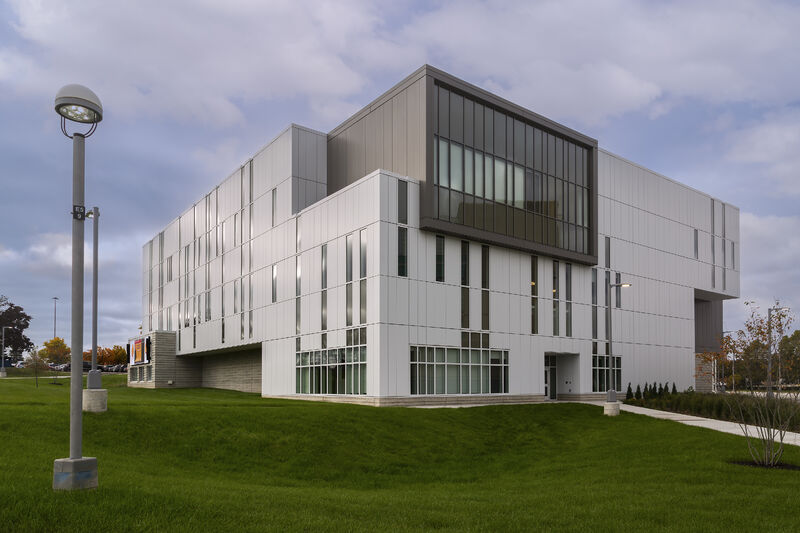The newest iteration of the U.S. Green Building Council’s (USGBC’s) LEED® green building program, LEED v5, is anticipated to launch in early 2025. This comes after an extensive drafting, revising and reviewing cycle.
The final public commenting phase concluded on Oct. 28, 2024. The LEED v5 rating system will be refined, and be presented for member ratification via ballot. After this version is fully adopted and in effect, what will it mean for aluminum framing and fenestration systems?
This blog series will attempt to put a finer point on the requirements of LEED v5 as it relates to aluminum-framed curtainwall, storefront, ribbon window, entrances and sun shading products. We’ll cover how each LEED credit category relates to these products, focusing on the following green building rating systems:
- LEED Building Design and Construction (BD+C): New Construction
- LEED BD+C: Core and Shell
- LEED Interior Design and Construction (ID+C): Commercial interiors

Photo by: Jeff Veltman, Vos Glass
Goals of v5
First, let’s look at what this latest revision to the LEED program hopes to accomplish overall.
According to the USGBC: “Every credit and prerequisite in LEED v5 has a connection to decarbonization, quality of life and/or ecological conservation, and this is annotated throughout the rating system so that project teams can easily shape their sustainability stories and communicate them.”
The three core goals every credit builds upon are:
- Decarbonization
- Quality of life
- Ecological conservation and restoration
The new LEED v5 credit scorecard will show how these goals are met by each credit or prerequisite.
What’s New
Overall
Carbon, climate resilience and social equity assessments are now prerequisites for every project. These requirements also trickle down into the credit categories.
Energy efficiency and embodied carbon have been “decoupled.” There is no longer one massive energy efficiency/carbon emissions credit. These now have taken their respective places separately in Energy and Atmosphere (EA) and Materials and Resources (MR) prerequisites. This means that it is easier to earn energy efficiency credit without complex whole building simulations. Carbon is further addressed differently from v4.1, where credits are gained by reducing the operational carbon and embodied carbon are awarded separately.

Photo courtesy of Seguin Gazette
Materials and Resources
MR credits have been completely revamped starting with the category’s “Assess and Quantify Embodied Carbon” newly added prerequisite. This prerequisite does not require reduction of embodied carbon. Instead, it requires tracking of the embodied carbon impacts and quantities of the covered structural, enclosure and hardscape materials for the project and comparison of the results to benchmark values. Reduction of carbon is now a separate MR credit.
Recycled content, material certifications and declarations now count toward the total for “Optimized Building Products,” which has been renamed “Building Product Disclosure and Optimization.” One of the themes here is the ability to seek credit with a multi-attribute compliance path instead of tracking those varying attributes through multiple credit paths. In essence, this simplifies the calculations required for this group of credits. Products are assigned a score based on mindful MATERIALS’ Common Materials Framework (CMF) and the five buckets set forth by the American Institute of Architects (AIA) Architecture & Design Materials Pledge, which will be described in part two of this blog series on LEED v5.
“Low-Emitting Materials,” often referred to as VOC-based credits, has moved from the Indoor Environmental Quality (EQ) credits to MR. Please be aware that under the “Low-Emitting Criteria” credit, “inherently non-emitting” is now listed as a compliance option. We will explain this and how it applies to fenestration in part three of this blog series.
Indoor Environmental Quality
Commercial fenestration and framing systems continue to bring value pertaining to views, thermal, sound, light and other aspects of the EQ “Occupant Experience” credit. Biophilic Environment presents up to four points for spaces that help people connect with nature. This includes creating indoor spaces with biophilic design elements and those with quality views of nature such as through glass with a visible light transmittance above 40%. Biophilic design also is referenced in the Sustainable Sites category’s “Accessible Outdoor Space” credit.
Sustainable Sites
LEED v5 also offers new credit opportunities for fenestration as part of the Sustainable Sites (SS) category. High-performance fenestration, framing and building envelope solutions may support resilient design credits, such as in hurricane and high-wind areas. Additionally, the “Resilient Spaces” credit, option 4, rewards designing spaces with operable windows and vents. One point is awarded if 50% of the regularly occupied spaces have operable units, and two if it has 75% or more. Bird-friendly glass also may add one point as part of the “Biodiverse Habitat” credit.
All in all, LEED v5 delivers a more straight forward approach with less calculation than its predecessor, while remaining laser-focused on core concepts like carbon reduction.
Our next blog in this series will offer a detailed summary of the MR credits as they apply to aluminum framing and fenestration.
Please contact your local architectural sales representative for personalized assistance with your projects seeking LEED certification.
